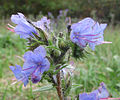Echium vulgare
- See also Viper's bugloss (moth) for the insect.
| Viper's bugloss | |
|---|---|

| |
| Scientific classification | |
| Kingdom: | |
| (unranked): | |
| (unranked): | |
| (unranked): | |
| Order: | |
| Family: | |
| Genus: | |
| Species: | E. vulgare
|
| Binomial name | |
| Echium vulgare | |
Echium vulgare — known as viper's bugloss and blueweed[1] — is a species of flowering plant in the borage family Boraginaceae. It is native to most of Europe, and western and central Asia[2][3] and it occurs as an introduced species in north-eastern North America.[1][4]
Description
It is a biennial or monocarpic perennial plant growing to 30–80 cm (12–31 in) tall, with rough, hairy, oblanceolate leaves.[5] The flowers start pink and turn vivid blue and are 15–20 mm (0.59–0.79 in) in a branched spike, with all the stamens protruding. The pollen is blue[6] but the filaments of the stamens remain red, contrasting against the blue flowers. It flowers between May and September. It is found in dry calcareous grassland and heaths, bare and waste places, along railways and roadsides, and on coastal cliffs, sand dunes and shingle.[7]
Distribution
It is native to Europe and temperate Asia. It has been introduced to North America and is naturalised in parts of the continent,[3] being listed as an invasive species in Washington state.[8]
Gallery
-
Viper's bugloss being pollinated by skipper butterflies
-
Illustration of Echium vulgare
-
Closeup of flower
-
Viper's bugloss colonizing the banks of Montreal city highway
-
White-tailed bumblebee on the blueweed
See also
References
- ^ a b Dickinson, T.; Metsger, D.; Bull, J.; & Dickinson, R. (2004) ROM Field Guide to Wildflowers of Ontario. Toronto:Royal Ontario Museum, p. 203.
- ^ Flora Europaea: Echium vulgare
- ^ a b Germplasm Resources Information Network: Echium vulgare
- ^ "Echium vulgare L." Retrieved 20 August 2015.
- ^ Graves, Melissa; Mangold, Jane; Jacobs, Jim. "Biology, Ecology and Management of Blueweed" (PDF). store.msuextension.org. Montana State University. Retrieved 22 October 2016.
- ^ Dorothy Hodges (1952). The pollen loads of the honeybee. Bee Research Association Ltd., London.
- ^ Fitter, R. & A. (1974). The Wild Flowers of Britain and Northern Europe. Collins.
- ^ "Common viper's bugloss: Echium vulgare (Lamiales: Boraginaceae): Invasive Plant Atlas of the United States". www.invasiveplantatlas.org. Invasive Pant Atlas of the United States. Retrieved 22 October 2016.





